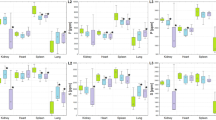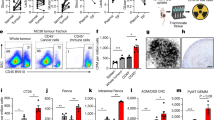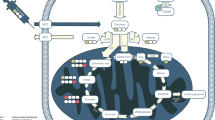Abstract
Six human melanoma xenograft lines grown s.c. in BALB/c-nu/nu mice were subjected to 31P-nuclear magnetic resonance (31P-NMR) spectroscopy in vivo. The following resonances were detected: phosphomonoesters (PME), inorganic phosphate (Pi), phosphodiesters (PDE), phosphocreatine (PCr) and nucleoside triphosphate gamma, alpha and beta (NTP gamma, alpha and beta). The main purpose of the work was to search for possible relationships between 31P-NMR resonance ratios and tumour pH on the one hand and blood supply per viable tumour cell on the other. The latter parameter was measured by using the 86Rb uptake method. Tumour bioenergetic status [the (PCr + NTP beta)/Pi resonance ratio], tumour pH and blood supply per viable tumour cell decreased with increasing tumour volume for five of the six xenograft lines. The decrease in tumour bioenergetic status was due to a decrease in the (PCr + NTP beta)/total resonance ratio as well as an increase in the Pi/total resonance ratio. The decrease in the (PCr + NTP beta)/total resonance ratio was mainly a consequence of a decrease in the PCr/total resonance ratio for two lines and mainly a consequence of a decrease in the NTP beta/total resonance ratio for three lines. The magnitude of the decrease in the (PCr + NTP beta)/total resonance ratio and the magnitude of the decrease in tumour pH were correlated to the magnitude of the decrease in blood supply per viable tumour cell. Tumour pH decreased with decreasing tumour bioenergetic status, and the magnitude of this decrease was larger for the tumour lines showing a high than for those showing a low blood supply per viable tumour cell. No correlations across the tumour lines were found between tumour pH and tumour bioenergetic status or any other resonance ratio on the one hand and blood supply per viable tumour cell on the other. The differences in the 31P-NMR spectrum between the tumour lines were probably caused by differences in the intrinsic biochemical properties of the tumour cells rather than by the differences in blood supply per viable tumour cell. Biochemical properties of particular importance included rate of respiration, glycolytic capacity and tolerance to hypoxic stress. On the other hand, tumour bioenergetic status and tumour pH were correlated to blood supply per viable tumour cell within individual tumour lines. These observations suggest that 31P-NMR spectroscopy may be developed to be a clinically useful method for monitoring tumour blood supply and parameters related to tumour blood supply during and after physiological intervention and tumour treatment. However, clinically useful parameters for prediction of tumour treatment resistance caused by insufficient blood supply can probably not be derived from a single 31P-NMR spectrum since correlations across tumour lines were not detected; additional information is needed.
This is a preview of subscription content, access via your institution
Access options
Subscribe to this journal
Receive 24 print issues and online access
$259.00 per year
only $10.79 per issue
Buy this article
- Purchase on Springer Link
- Instant access to full article PDF
Prices may be subject to local taxes which are calculated during checkout
Similar content being viewed by others
Author information
Authors and Affiliations
Rights and permissions
About this article
Cite this article
Lyng, H., Olsen, D., Southon, T. et al. 31P-nuclear magnetic resonance spectroscopy in vivo of six human melanoma xenograft lines: tumour bioenergetic status and blood supply. Br J Cancer 68, 1061–1070 (1993). https://doi.org/10.1038/bjc.1993.483
Issue Date:
DOI: https://doi.org/10.1038/bjc.1993.483



